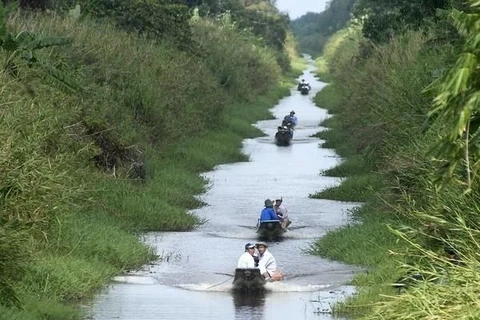Hanoi (VNA) - Blessed with huge potential, yet the tourism sector in the Mekong Delta have still failed to achieve an outstanding growth, one of the causes of which pointed out by delegates is wastes and traffic.
The Mekong Delta has been known far and wide for long as a magnet to tourists thanks to its green space and orchards, crisscrossed by canals. Advantageous in geographic location and resources, yet local tourism sectors still fail to create a breakthrough growth matching the potential of the region.
The Association of Mekong Delta Tourism recently held a tourism promotion and popularisation conference for the region in Hanoi, which came within the framework of the ongoing Vietnam International Travel Mart – VITM Hanoi 2019, from March 27 to 30.
Wastes “drown” tourism
Vice President of the association Pham The Trieu said that in the past five years, tourism in the Mekong Delta obtained an annual growth of over 10 percent in terms of tourists who stay overnight and turnover. Last year, the region welcomed 40.7 million arrivals to tourism sites.
The official further said that over the recent years, regional localities have built products typical for the delta and currently, they are developing the MICE.
Localities are also continuing to promote unique products like Ninh Kieu wharf, Cai Rang floating market, Tra Su cajeput forest, Plain of Reeds, Ca Mau cape, etc.
Blessed with such huge potential, yet regional tourism still fails to achieve an outstanding growth, one of the causes of which is pointed out by delegates as wastes and traffic.
Former Deputy General Director of the Vietnam National Administration of Tourism Dang Van Tien said he even advised operators to not conduct cruises for tourists when the tide ebbs as too much wastes will be exposed.
Sharing the same worry, President of the association Tran Viet Phuong said that over the many years, Can Tho city has been building a project to ensure environment hygiene, but to no avail.
Facing the reality, the delegates agreed that localities need to upgrade and build new tourist sites besides calling for investors to tap into regional potential.
Solutions for “bottlenecks”
Over the recent years, infrastructures in the region have got a facelift but, except for Phu Quoc in Kien Giang province, no other localities have had multiple-star resort or recreation centres of the international level. It will be very hard for the regional tourism to compete with others throughout the country if it does not change.
Deputy General Director of the administration Nguyen Thi Thanh Huong held that tourism infrastructures and services in the region are generally developing slowing, with almost similar products that cannot make differences.
The official stressed that the Mekong Delta tourism needs to attract major and specialised investors, service providers need to access travel firms, and promotion activities should be held.
For his part, President of the Vietnam Tourism Association Nguyen Huu Tho asserted that community tourism and farmstay are the shortest way for locals to get rid of poverty and to leave an inerasable impression on visitors.
President Phuong affirmed that the leadership of his association will pool ideas raised at the conference to provide consultation to the local People’s Committees, boost promotion activities, and take concerted measures to deal with environment sanity.
The traffic in the Mekong Delta will become more convenient in the time to come when the Vam Cong bridge is open to traffic in June, liking Lap Vo district of Dong Thap province to Thot Not district of Can Tho city.
Besides, by the end of May, the Can Tho airport will open more routes linking to Thailand, Malaysia, Vinh, Thanh Hoa, Hai Phong, Nha Trang, Da Lat, etc., thus further facilitating the attraction of tourists to the Mekong Delta. All these are expected to create a facelift for the Mekong Delta./.





























